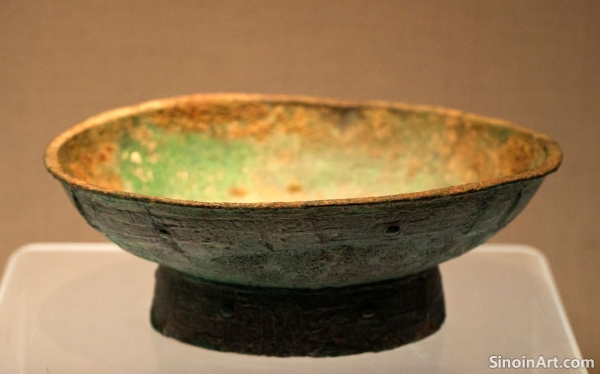The Influence of Tang Dynasty Kaishu Calligraphy on Bronze Inscriptions
|
While bronze inscriptions reached a peak of prevalence during the Zhou Dynasty, the Tang Dynasty, known for its advancements in calligraphy, saw a notable shift in the style and aesthetic of bronze inscriptions, particularly reflecting the influence of Tang Kaishu script. The aesthetic ideals of calligraphy began to influence the way that inscriptions were carved in bronze.  The elegant and structured forms of Tang Kaishu influenced the way that characters were carved on bronze objects, from dedicatory inscriptions on temple bells to more decorative text on mirrors and plaques. The influence of the elegant and precise style of Kaishu is very evident in the design of this era. The emphasis on clarity, precision, and elegance helped to shape the aesthetic of the new bronze works.  The precise brushstrokes and balanced compositions of Kaishu were adapted to the constraints of metal carving, often resulting in inscriptions that are both clear and artistically appealing. The transfer of these styles from brush to metal is a testament to the skill and expertise of the carvers of the era. The skills of both calligraphers and metalworkers are on display in this fusion of media.  The emphasis on aesthetic principles and refined craftsmanship during the Tang Dynasty also led to a greater appreciation for beauty and elegance in bronze inscriptions, transforming them from simple records into works of art in their own right. The emphasis on beauty and grace changed the way in which bronze inscriptions were viewed and created. The addition of elegance and artistic vision helped to change the status of the inscriptions. The study of bronze inscriptions from the Tang Dynasty reveals not only the stylistic changes that occurred during the period but also the interconnectedness of calligraphy, metalworking, and the aesthetic sensibilities of the time. The combination of different artistic approaches helped to make this a particularly creative and noteworthy period in Chinese history. |
Tag : Tang Dynasty inscriptions, Kaishu influence, bronze calligraphy, Chinese calligraphy, metal carving
Related information
- The Role of Bronze in Ancient Chinese Funerary Practices: Preparing the Deceased for the Afterlife
- The Future of Bronze Ware Studies: New Research Methods and Technologies
- The Craftsmanship Behind Chinese Bronze Ware: Techniques and Methods
- Bronze Mirrors and Ancient Chinese Beliefs About the Soul: Reflection and Transformation
- The Ritual Use of Bronze Mirrors in Ancient China: Connecting Worlds and Warding Off Evil
This article explores the role of bronze in ancient Chinese funerary practices, highlighting the inclusion of ritual vessels, weapons, mirrors and other objects, and how these items reveal beliefs about the afterlife and the preparation of the deceased for their journey.
This article explores the future of Chinese bronze ware studies, highlighting the use of new research methods and technologies, including advanced imaging, 3D modeling, isotopic analysis, and interdisciplinary approaches, which promise to enhance our understanding of these artifacts.
This article explores the craftsmanship behind Chinese bronze ware, detailing the lost-wax casting method, the composition of bronze alloys, and the intricate techniques used to create the detailed designs, highlighting the technical mastery of ancient bronze workers.
This article explores the connection between bronze mirrors and ancient Chinese beliefs about the soul, highlighting their role as guides in the afterlife, their association with spiritual transformation, and the belief that they could capture and preserve the soul's essence.
This article explores the ritual use of bronze mirrors in ancient China, highlighting their role in guiding souls in the afterlife, in divination practices, in warding off evil, and demonstrating the powerful spiritual beliefs associated with these reflective objects.